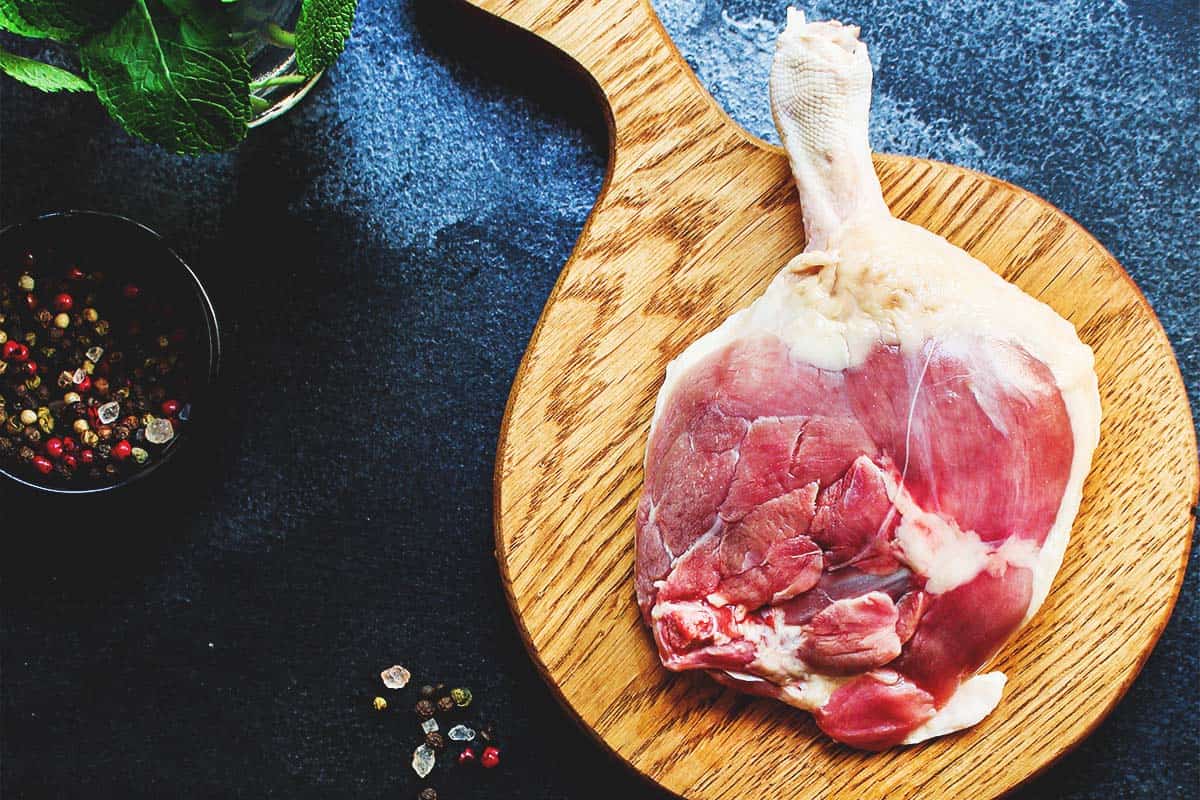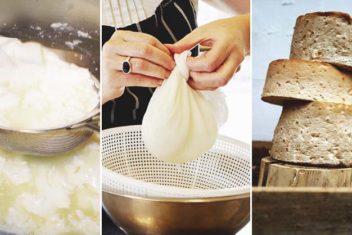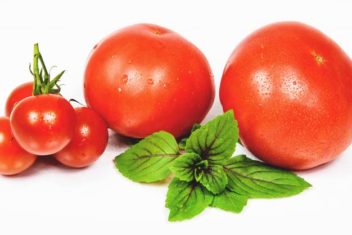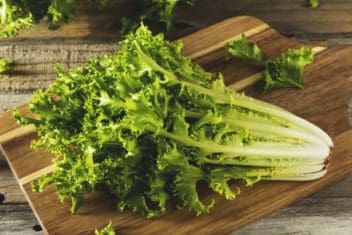When you say things in French they seem somehow more exciting and delicious. Confit, for instance, comes from the French word “confire” which literally means ‘to preserve.’ So, when you see that word tied to things like duck or violets, you can translate that to preserved duck meat or preserved violet flowers.
Yet, anyone who has ever enjoyed a proper confit knows your tastebuds translate it as “to make more delicious through the act of preservation”. Ordinary food items are transformed into delicacies that transcend the simplicity in their preparation. In other words, when you make confit, you also practice food magic.
Duck confit is the most famous kind, but you can actually confit all sorts of things. Vegetables, flowers, fragrant herbs, and many types of meat are great candidates for confit. If you want to confit garlic from your garden, ducks you processed at home, or violets you foraged from your organic lawn, read on to learn more about confit preparations.
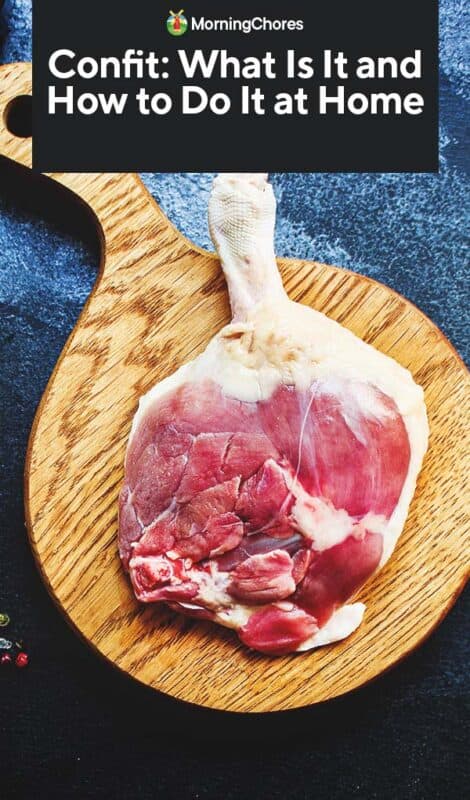
Short Term Preservation
Before we get too deep into the confit processes, let me warn you that confit is a short-term preservation technique. Depending on what you confit, it may last for a few weeks or a couple of months.
Unless you freeze your confit or pressure can it, you still need to keep confit items in the fridge to make them last. If you don’t, they could be at risk for botulism.
Now with that safety warning out of the way, let’s get into the basics of confit.
Traditional vs. Modern Confit

Traditionally the term confit applied to the preservation of meat. Most commonly this was leg meat from ducks, geese, or rabbits. Those cuts could be chewy and stringy, especially on older animals. So, you wouldn’t want to salt cure them as you might a hind of pork.
The Lard Lid
Instead, those tough cuts were slow-cooked in fat on low temperatures to make them tender. Then they were put in crocks and covered with an inch or so of melted fat such as pork lard. The lard acted like an airtight lid to keep bacteria out.
Those fat-sealed containers could keep in a root cellar for most of the winter in areas with cold temperatures. With the discovery of vacuum sealing and canning, though, most people opted for these safer storage methods.
Modern Confit
Also, these days, most people don’t have root cellars with temperatures that stay between 45-55℉ all winter. So, instead of root cellars, we keep our confit preparations in the fridge.
Today, meat confit isn’t just a storage method. It’s a delicacy. A single leg of mass produced duck, prepared confit-style, can cost between $10-$25 depending on the brand. These are also usually sold in plastic vacuum wrappers without all the delicious fat they were cooked in.
For duck leg confit packed in duck fat, from ducks raised organically on pasture and ponds, the cost is much higher.
Confit Craze
Also, these days, the term confit doesn’t just apply to tough, stringy cuts of meat. People make confit with animals processed while young and tender, vegetables, and even fruits and flowers.
The term confit has now evolved to encompass slow cooking anything on low temperature in fat. It can even be used to describe preserving things with pectin and sugar.
Let’s look at a few different kinds of confit and how to make them.
How to Make Classic Meat Confit
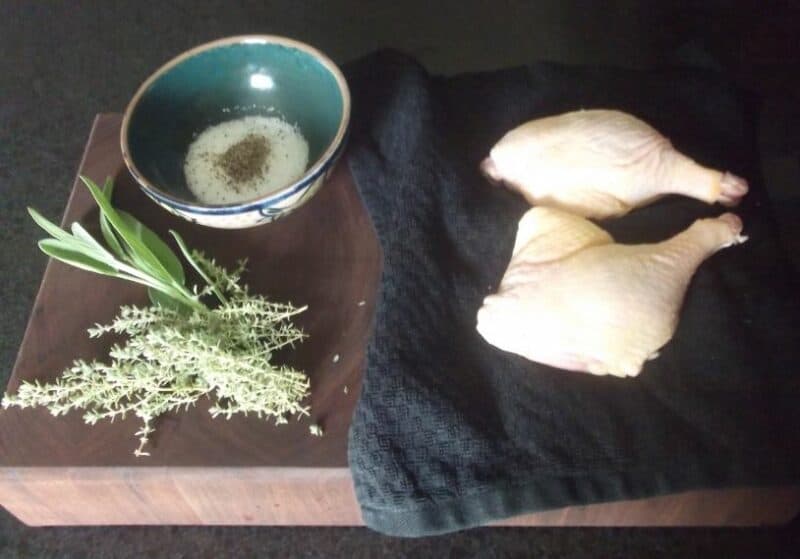
The classic meat confit is still my favorite. Here’s how to make it.
Step 1: Choose Your Meat
You can technically use any cut of meat. However, tougher cuts hold up better during slow cooking.
Poultry legs and wings, especially duck, are my personal favorites. Yet, this also works well with a pork shank or shoulder, any part of a rabbit, quail, and stew beef.
Step 2: Salt and Savory It
Once you pick your meat cut, massage it with salt and herbs. I use a tablespoon of salt per pound of meat. De-stemmed, chopped rosemary, thyme, and French tarragon are great herb options. You can also add a dash of ground spice like star anise, allspice, or true cinnamon (not cassia cinnamon).
Step 3: Age and Rest
Cover your seasoned meat and keep in your fridge for 2-3 days to allow the meat to age and relax. Then remove it from the fridge and wipe off the extra salt and spices with a cloth or paper towel.
Step 4: Submerse in Fat
Put the meat in the smallest oven-safe pan or crock it will fit in. Then cover the meat with fat. The fat of the animal you are cooking is traditionally used for this.
Personally, though, I think pork lard, duck fat, or butter produce a better end-product than beef tallow, even when making beef confit. The key element is that the meat must be fully submerged in fat the entire time it cooks.
The amount of fat required depends on the size of what you cook it in. But I usually have a few cups of melted fat on hand for this to make sure the meat stays covered.
Bonus – Flavored Cooking Fat!
Also, after cooking you can use any extra fat with all that delicious meat, herb, spice, and salty flavor for cooking other things. So, I sometimes add extra butter and duck fat just to be able to keep some for cooking my mustard greens or kale. It’s like using bacon grease, only herbier.
Step 5: Slow Cook
Now, the magic happens. Put the lid on your oven dish and cook the meat at 200℉. Exact cooking time varies by meat cut. So I check it once an hour to make sure the meat stays submerged in fat and to test for tenderness. Your confit is ready when it is super tender but not falling off the bone.
Duck legs from ducks harvested under 6 months of age usually take about 4 hours. Game birds, beef, and goose may take a little longer. Pork will depend on the cut. The shoulder cooks soft a lot sooner than the shank.
If your meat doesn’t feel like you could pry it apart with your fingers, then it needs a little longer. But if it starts to string too easily, then it’s time to get it out of the oven.
Step 6: Confit
You can technically take your meat out of the oven and eat it straight away. But then it would just be delicious fat roasted meat, not confit. To make it confit, you need to put the meat in a container such as a wide flat canning jar or vacuum lidded glass container.
After that, pour the fat over the meat in the container. Use a spoon to press the fat to make sure it gets all around the meat so there are no air holes. Then, top of the container with at least another half inch of fat to protect the meat inside.
Now close the container and let it cool on the counter. Once cool, put the container in the fridge for two weeks. The meat takes on a much richer taste and texture if you age it in fat like this.
Step 7: Serve

After that two week confit waiting period, you can tear apart the meat and serve it on a salad. Or you can warm it up and put it over a bed of lentils or cannellini beans. You can make a sourdough sandwich with it. Or, you can pick it apart and eat it with your fingers in a true rustic fashion.
How you use it is really up to you. But once you’ve tried meat confit, I am sure you’ll find lots of reasons to make it and use it at home.
Fruit and Vegetable Confit Ideas
Now, as I mentioned, you can confit a whole lot more than meat. People are doing it with fruits and vegetables. The basic process is similar. You will slow cook your chosen fruits and vegetables in a whole lot of fat. But, exactly how you do that varies by what you cook.
Here are a few variations to inspire you.
1. Tomato Confit
With tomato confit, you don’t need to fully submerge your tomatoes in fat. They are so juicy, all you need to do is top them off with a tablespoon or two of butter, duck fat, or even some kind of delicious nut oil.
Also, for tomatoes, you don’t need to cook them for hours. Depending on the size and type of tomato, they can be done in 30-60 minutes.
Finally, salting tomatoes and putting them in the fridge for 2-3 days before cooking is a bad idea. Instead, sprinkle them with a little salt and fresh herbs right before you spoon on your fat and cook them.
After cooking, you can eat your tomatoes right away. Or, better yet, put them a jar and mash them with some of the fat liquid from the pan. Then you can spread them on bread every time you need a savory snack.
These hold up for a week or two in the fridge and longer if you can or freeze them.
2. Garlic or Onion Confit
Garlic is another popular choice for making confit. Just remove the skins and slow cook the cloves in butter. Then, mash the garlic and butter into a jar to make a garlic butter confit spread. You can use this to flavor your pan when cooking fish, meat, or vegetables.
Onions also work the same way. Just chop them into garlic clove-sized pieces before cooking.
3. Apple or Pear Confit
Apples and pears taste amazing when slow cooked with butter and herbs like rosemary and thyme. If you want to make them savory, use salted butter. If you want to make them sweet use unsalted butter and add a little brandy or sugar to accentuate the natural sweetness in the fruit.
For fruit, you can make your confit on the stovetop over low heat or in the oven like a regular confit. Cube or slice the fruit to reduce cooking time. You can keep it chunky by cooking less or go all the way to soft by cooking longer.
The finished product can be spread on tart shells as the filling or on toast like jam and butter all in one. I love to use this with goat cheese and blinis for a quick amuse-bouche or appetizer.
Confiture
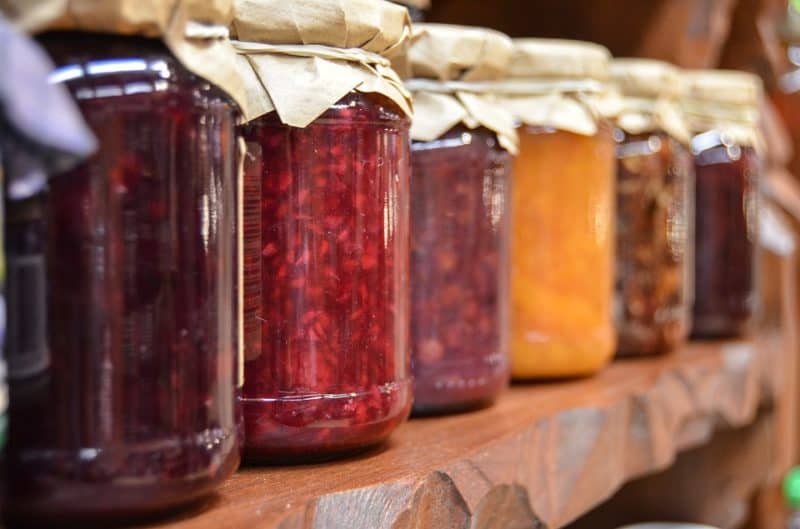
There is one last class of confit that deserves mention. Sometimes you’ll come across products called Confit de Violette or Confit de Rose. This is another way of saying jam.
These products are more commonly referred to as “confiture” when you buy them in France. But, here in the states, since the word confit is so popular among foodies, you sometimes see it used on floral or herb jams.
Just like making fruit jam, you can make your own confit of flowers or herbs with no difficulty. All you need is flower petals or de-stemmed herb leaves, sugar, water, lemon juice, and pectin.
Foraged violets, roses, chamomile, mint, and more all make good options for making fragrant, fancy confiture at home. Try this super simple rose petal recipe to get familiar with the process. Then, substitute in other delicious flowers or herb leaves for the rose petals for more variety.
Confit at Home
Don’t let fancy French words keep you from making rustic farm foods like confit part of your everyday eating options. As long as you have great ingredients, a little time to cook, and a spirit of adventure, you can make all sorts of gourmet favorites at home.
